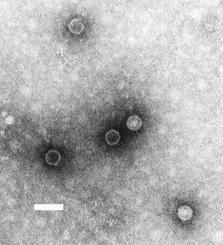Introduction

Poliovirus is a small, non-enveloped, RNA virus that belongs to the genus Enterovirus and the family Picornaviridae. It is the causative agent of poliomyelitis (commonly known as polio), a potentially disabling and sometimes fatal disease that primarily affects the nervous system. Poliovirus is highly contagious and mainly spreads through the fecal-oral route. There are three serotypes of poliovirus (types 1, 2, and 3), each capable of causing paralysis.
Summary of Poliovirus
- Poliovirus is a dangerous virus that spreads easily and can cause lifelong paralysis, especially in children under five.
- There are three types of poliovirus, and only strong vaccination can protect against all of them.
- Learn about the poliovirus its types, how it spreads, and what we can do to prevent and control this deadly disease.
Table of Contents
Characteristics of Poliovirus
Poliovirus belongs to the Picornaviridae family and the Enterovirus genus. Here are some key characteristics:
- Size and Shape: Poliovirus is very small, about 27 nanometers in size, and has a round (icosahedral) shape.
- Genetic Material: It has single-stranded RNA as its genetic material.
- Capsid: The RNA is protected by a protein shell called a capsid. It does not have an envelope (meaning it’s a “naked” virus).
- Resistance: It can survive in the environment for a long time, especially in water or feces. It is resistant to stomach acids, so it can survive the digestive tract.
- Types: There are three main types of poliovirus (Type 1, Type 2, and Type 3).
Epidemiology
Epidemiology is the study of how a disease spreads and affects people. Poliovirus is mainly found in areas with poor sanitation and hygiene. Here’s how it spreads:
- Affected Population: Mostly children under the age of 5 are affected. However, unvaccinated adults can also get the disease.
- Endemic Areas: In the past, polio was common all over the world. Now, it’s mostly found in countries like Afghanistan and Pakistan.
- Eradication Efforts: Through strong global vaccination programs, most countries have eliminated polio.
- Seasonal Pattern: Polio cases are more common during summer and rainy seasons when water contamination is high.
Serotypes of Poliovirus
There are three serotypes of poliovirus. A serotype means a variation of the virus that is identified by the immune system in a different way:
Poliovirus Type 1 (PV1)

- Most commonly found.
- Causes the majority of paralysis cases.
- Most resistant to the immune response.
Poliovirus Type 2 (PV2)
- Was responsible for many outbreaks in the past.
- Declared eradicated in 2015 globally.
Poliovirus Type 3 (PV3)

- Less common than Type 1.
- Also declared eradicated in 2019.
- Only Type 1 poliovirus is still circulating in the wild today.
Mode of Transmission
Poliovirus spreads mainly through the fecal-oral route. That means:
- Main Source: The virus comes out of the body in the feces (stool) of an infected person.
- Contaminated Food/Water: If someone eats food or drinks water contaminated with this stool, they can get infected.
- Poor Hygiene: In places without clean toilets or proper handwashing, the virus spreads easily.
- Less Common Route: It can also spread through droplets from coughs or sneezes but this is rare.
Once it enters the body, the virus multiplies in the intestines and from there, it may enter the bloodstream and travel to the nervous system.
Pathogenesis (How the Virus Causes Disease)
The pathogenesis of poliovirus means the process by which the virus causes disease:
- Entry: The virus enters through the mouth.
- Multiplication in Throat and Intestines: It first multiplies in the cells of the throat and intestines.
- Spreads to Lymph Nodes and Bloodstream: From the intestines, it reaches the lymphatic system and then enters the bloodstream.
- Crosses to the Nervous System: In some cases, it crosses the blood-brain barrier and enters the central nervous system.
- Attack on Nerve Cells: It attacks motor neurons in the spinal cord and brainstem. These neurons control muscles.
- Paralysis: When motor neurons are damaged, the muscles can no longer work properly, leading to muscle weakness or paralysis.
In many people, the virus never goes beyond the intestines, so they show no symptoms but can still spread the virus.
Clinical Manifestation (Symptoms of Polio)
Polio can cause different symptoms depending on how the virus affects the body. There are three major forms:
A. Asymptomatic (No Symptoms):
- About 90–95% of infected people show no symptoms.
- These people are still contagious.
B. Minor Illness (Abortive Poliomyelitis):
- Affects about 4–8% of infected people.
- Symptoms include:
- Fever
- Sore throat
- Tiredness
- Headache
- Vomiting
- Stomach pain
- These symptoms usually go away in 2–3 days.
C. Non-Paralytic Poliomyelitis:
- Involves the central nervous system but does not cause paralysis.
- Symptoms include:
- Stiff neck
- Back pain
- Muscle spasms
- Lasts for a few days.
D. Paralytic Poliomyelitis:
- This is the most severe form.
- Very rare (less than 1% of cases).
- Symptoms include:
- Sudden onset of weakness in legs or arms.
- Difficulty in breathing or swallowing if respiratory muscles are affected.
- Permanent paralysis in some cases.
- In worst cases, it can lead to death.
7. Laboratory Diagnosis
To confirm if a person has polio, doctors and scientists use laboratory tests. These include:
- Sample Collection:
- Stool samples are the most reliable (as the virus is present in feces).
- Throat swabs or cerebrospinal fluid (from spinal tap) may also be used.
- Virus Isolation:
- The virus can be grown in special lab cells from the stool samples.
- Polymerase Chain Reaction (PCR):
- PCR is used to detect poliovirus RNA in the sample.
- It also helps to identify which serotype is present.
- Serology:
- Blood tests can detect antibodies against poliovirus.
- Used mostly in outbreak investigations, not routine cases.
- Differentiation from Vaccine Strains:
- In vaccinated individuals, lab tests help to distinguish between wild poliovirus and vaccine-derived virus.
8. Prevention and Control
A. Vaccination
Vaccination is the most important method to prevent polio. Two main types of vaccines are used:
1. Oral Polio Vaccine (OPV):
- Live, weakened virus given by mouth.
- Easy to give and cheap.
- Provides gut immunity, which helps stop virus transmission.
- Can rarely cause vaccine-associated polio (VAPP).
- Used widely in mass campaigns.
2. Inactivated Polio Vaccine (IPV):
- Contains killed virus.
- Given by injection.
- Very safe; no risk of VAPP.
- Gives good protection in the bloodstream but less in the gut.
Immunization Schedule
- Most countries follow a routine immunization schedule starting from 6 weeks of age.
- Booster doses are needed to ensure long-lasting protection.
Global Polio Eradication Initiative (GPEI)
- Started in 1988 by WHO, UNICEF, and other partners.
- Aimed at complete eradication of polio from the world.
- Has reduced cases by over 99% globally.
Surveillance
- Continuous monitoring of any new polio cases.
- Lab testing of stool samples from people with sudden paralysis.
- Environmental testing of sewage water.
Hygiene and Sanitation
- Handwashing with soap.
- Using clean water and proper toilets.
- Avoiding open defecation.
Public Awareness
- Educating people about the importance of vaccination.
- Fighting rumors and misinformation.
- Engaging community leaders to promote vaccine acceptance.
Conclusion
Poliovirus is a deadly virus that can cause lifelong paralysis and even death, especially in young children. However, with the help of safe and effective vaccines, polio has been almost eliminated in most parts of the world. The key to complete eradication lies in proper vaccination, surveillance, and public cooperation.
Even one case of polio in any part of the world is a threat to children everywhere, so global efforts must continue until the virus is gone forever. By understanding the nature of poliovirus and the way it spreads and affects the body, we can take the right steps to protect ourselves and others from this dangerous disease.
Frequently Asked Questions (FAQs)
What are the early signs of poliovirus infection?
Most individuals infected with poliovirus exhibit no symptoms. However, about 24% may experience mild, flu-like symptoms such as sore throat, fever, nausea, vomiting, and fatigue. A smaller percentage (1%–5%) develop nonparalytic aseptic meningitis, characterized by stiffness in the neck, back, and/or legs. Less than 1% of infections result in flaccid paralysis, leading to permanent weakness or paralysis of limbs.
How does poliovirus spread in communities?
Poliovirus primarily spreads through the fecal-oral route, entering the body via the mouth through contaminated water or food. The virus multiplies in the intestine and is excreted in feces, which can contaminate water sources and infect others. In areas with poor sanitation, this mode of transmission facilitates rapid community spread.
Can adults contract poliovirus, or is it only a childhood disease?
While poliovirus predominantly affects children under 5 years of age, adults can also contract the virus, especially if they are unvaccinated or have weakened immune systems. In adults, the disease may present similarly to children, ranging from asymptomatic to severe forms, including paralysis.
Related Articles




